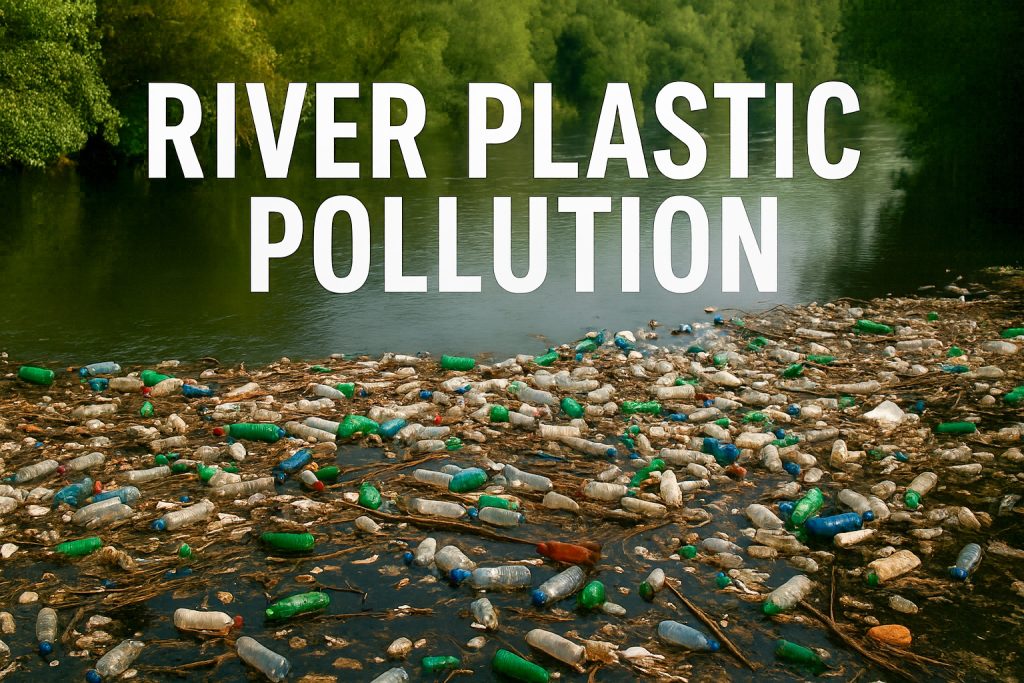Discover how river plastic pollution drives the ocean crisis. Learn which rivers pollute most, the impacts on ecosystems, and the solutions ahead.
Rivers are more than lifelines for people and wildlife — they are also the main arteries of the planet’s plastic problem. Acting as conveyor belts, they collect waste from streets, landfills, and industrial zones, flushing it toward the coast. This river plastic pollution now accounts for a large share of the millions of tonnes of plastic entering the sea each year, choking marine ecosystems and threatening food security worldwide. Understanding how this flow begins — and where it can be stopped — is key to ending the ocean’s plastic crisis.
Explore the world’s most polluted rivers and their shocking realities
How Rivers Become Plastic Highways
Urban Runoff
In cities, every rainfall acts like a street sweeper — but instead of cleaning, it carries trouble. Litter tossed aside, cigarette butts, food packaging, and microplastics from car tires are flushed into storm drains. From there, they join small creeks or canals, eventually finding their way into larger rivers. This constant wash of urban debris turns stormwater networks into direct feeders of river plastic pollution.
Waste Mismanagement
In many parts of the world, waste collection systems are incomplete or nonexistent. Rubbish piles up along roadsides, in empty lots, and especially near riverbanks. When seasonal rains or flash floods arrive, these makeshift dumps are quickly scoured clean — sending a wave of plastic downstream. Even areas far from the coast contribute to marine pollution through this inland-to-ocean pipeline.
Industrial Discharge
Plastic pollution isn’t just a post-consumer problem. Factories making packaging, textiles, and plastic products often leak or spill raw plastic pellets (called nurdles) into local waterways. Without proper containment measures, these tiny pellets travel vast distances, becoming one of the most pervasive forms of microplastic found in rivers and oceans alike.
Agricultural Plastic
Modern agriculture relies heavily on plastics — from thin mulch films that cover fields to drip irrigation tubing and fertilizer bags. Over time, sun and weather break these materials into fragments. Heavy rain or irrigation runoff washes them into drainage ditches, then into rivers. Because these plastics are often thin and lightweight, they float easily and travel long distances toward the sea.
The Biggest Culprits
While thousands of rivers flow into the world’s oceans, research shows that a startlingly small group is responsible for most of the plastic load. Studies by environmental scientists and organizations such as The Ocean Cleanup suggest that just 10–20 rivers may transport over 80% of all river-borne plastic into the sea. These waterways often share common traits — they pass through densely populated regions, lack effective waste management systems, and experience seasonal floods that flush accumulated debris downstream.
Key examples include:
- Yangtze River (China): Asia’s longest river and the world’s leading conveyor of plastic to the sea. Flowing through megacities and industrial zones, the Yangtze gathers enormous amounts of waste before releasing it into the East China Sea.
- Ganges River (India/Bangladesh): Revered as sacred yet suffering from severe pollution, the Ganges receives untreated urban waste, religious offerings wrapped in plastic, and agricultural debris, all of which ultimately pour into the Bay of Bengal.
- Nile (Africa): North Africa’s lifeline also acts as a plastic corridor. Cairo’s plastic waste — from single-use bags to drink bottles — drifts north, eventually spilling into the Mediterranean, where circulation patterns trap debris for decades.
- Mekong (Southeast Asia): Stretching from the Tibetan Plateau to the South China Sea, the Mekong passes through rural farmlands, growing cities, and sprawling markets. Plastic from fishing gear, packaging, and consumer goods mixes along its route, making it one of the region’s largest contributors to marine litter.
These rivers illustrate a global truth: plastic pollution is not evenly spread, but intensely concentrated. Tackling the problem at these major sources could drastically cut the overall flow of plastic into the ocean.
Why is it mostly Asia?
Many of the top-polluting rivers are in Asia because the region combines high population density, rapid economic growth, and limited waste management infrastructure. Coastal megacities, booming manufacturing hubs, and widespread use of single-use plastics create huge waste streams. In tropical and monsoon climates, heavy seasonal rains and river flooding quickly wash mismanaged waste into waterways. Cultural and economic reliance on rivers for transportation, fishing, and commerce further increases the flow of plastic into the water.
The Hidden Threat: Microplastics
Not all river-borne plastic pollution is visible as bottles and bags drifting downstream. Over time, sun, waves, and friction break larger plastic debris into microscopic fragments known as microplastics — particles less than 5 millimeters in size. These can originate from degrading waste, but also from everyday sources like synthetic clothing fibers released during washing, or “nurdles,” the raw plastic pellets used in manufacturing.
Because of their size, microplastics slip easily through wastewater treatment systems, passing into rivers unnoticed. Once in the water, they mingle with sediment, float at the surface, or remain suspended in the current, infiltrating every layer of the aquatic ecosystem.
The real danger lies in their bioavailability — microplastics are small enough to be eaten by plankton, mussels, shrimp, and other tiny organisms at the base of the food web. From there, they work their way up the food chain, accumulating in fish, shellfish, and eventually humans. Many microplastics carry absorbed toxic chemicals such as pesticides and heavy metals, adding a further layer of risk to wildlife and human health.
In rivers, these particles don’t just disappear — they can linger for decades, continually moving between sediment, water, and living organisms until they are carried to the sea. By the time they reach the ocean, they are nearly impossible to remove, making prevention at the river stage critical.
Impacts on River and Marine Life
Plastic pollution doesn’t just spoil the beauty of rivers and coastlines — it creates a cascade of harm throughout aquatic ecosystems.
Ingestion and Starvation
Fish, turtles, seabirds, and even tiny plankton mistake floating plastic for food. Once swallowed, these indigestible fragments take up space in the stomach, reducing the urge to feed and leading to malnutrition, weakness, or starvation. Sharp-edged pieces can also cause internal injuries or blockages.
Poisoning and Chemical Contamination
Plastics themselves contain additives like phthalates and flame retardants, but they also act like chemical sponges, absorbing pesticides, heavy metals, and other pollutants from the water. When animals ingest these plastics, the toxins can leach into their bodies, damaging organs, disrupting hormones, and impairing reproduction.
Entanglement and Physical Trauma
Abandoned fishing nets (“ghost gear”), plastic strapping, and six-pack rings ensnare fish, mammals, and birds. Entangled animals may drown, lose limbs, or suffer infections from deep cuts. For species like river dolphins, seals, and manatees, entanglement is often fatal.
Ecosystem-Wide Disruption
Microplastics are small enough to be eaten by the tiniest zooplankton, altering the base of the food web. Over time, these particles move up through the chain, affecting larger predators and, ultimately, human consumers. This contamination can weaken entire fish populations, disrupt breeding cycles, and threaten the livelihoods of communities that depend on healthy rivers and seas.
Solutions & Global Initiatives
Plastic pollution in rivers is a global problem — but it’s one we can tackle at the source with coordinated action, innovation, and community involvement.
Improved Waste Management
Stopping plastic at its origin is the most effective solution. This means expanding waste collection in urban and rural areas, ensuring proper disposal or recycling, and building infrastructure that can handle the rapidly growing volume of single-use plastics. Countries like South Korea and Germany have demonstrated that strict waste separation and recycling incentives can dramatically reduce plastic leakage into waterways.
River Cleanup Projects
Technology is playing a growing role in cleaning existing pollution from rivers. Projects like The Ocean Cleanup’s Interceptor units — deployed in places such as the Klang River (Malaysia) and Cengkareng Drain (Jakarta, Indonesia) — capture floating debris before it reaches the ocean. Other initiatives use floating booms, trash traps, and nets designed to work with natural currents without harming wildlife.
Bans & Sustainable Alternatives
Legislative action is critical. Dozens of countries have banned or taxed single-use items like plastic bags, straws, and polystyrene containers. At the same time, industries and startups are developing biodegradable packaging made from plant fibers, seaweed, or compostable polymers. While not a complete replacement, these alternatives can significantly reduce long-term pollution.
Community Action & Education
Grassroots efforts remain the backbone of river protection. Local groups organize riverbank cleanups, citizen science projects to track pollution sources, and education campaigns in schools and communities. Initiatives like World Cleanup Day mobilize millions of volunteers globally, proving that public awareness and participation can accelerate change.
Conclusion
Oceans start far inland. Every bottle tossed on a riverbank or plastic bag swept into a storm drain may one day drift into the open sea. Addressing river-borne plastic pollution is not just about protecting marine life — it’s about rethinking how we handle waste at its source.


